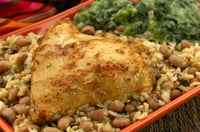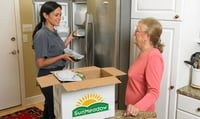The most important component of food safety is employee training. Though some foodborne illnesses can be traced to specific suppliers, the manner in which food is handled is usually the culprit.
Investing in training procedures that educate food handlers about the proper way to prepare food is of the utmost importance. Something as simple as an unwashed hand or a seemingly innocent sneeze really can compromise the integrity of a food product. Too many food service providers make the critical mistake of assuming that food handlers understand the nuances of proper personal hygiene. Some employees mistakenly believe that their personal hygiene is up to par when, in reality, it does not meet the standards of their employer.
 1. Proper Hand Washing
1. Proper Hand Washing
Every food service worker should be thoroughly trained in regard to how to clean his hands. Simply running warm water over one’s hands with a dab of soap will not provide a comprehensive clean that guarantees food safety. Rather, employees must be shown how to properly wash their hands. They should have the opportunity to view an in-person demonstration as to how hands must be cleaned before work starts, before returning from break/lunch and after using the restroom. To the surprise of many, a thorough hand-cleaning requires the use of hot water and anti-bacterial soap for a minimum of 20 seconds. Employees should be taught to perform a mental countdown during this hand-washing period to ensure their hands are thoroughly cleaned. Even the lower portion of the wrists should be cleaned as this area often comes into contact with food, dishes and utensils.
2. Correct Food Handling
It is imperative that food service providers train their staff to handle food in the proper manner. Every food service worker should use gloves unless gloves preclude the proper preparation of the food. The unfortunate truth is that few food service workers use food prep gloves as they should. Plenty of food service workers will touch food with their bare hands, assuming that a hand-washing performed hours ago will prevent the transmission of harmful bacteria and other particles that can cause illness. Food service managers should explain that touching knife handles, cutting boards, pots, pans, trays and other kitchen items can result in tainted food. Each of these kitchen items has the potential to harbor germs and viruses. Merely touching a pan’s handle with one’s hand and then using that hand to prepare food can spread germs to a diner’s meal. Employees must also be trained to discard their gloves after they have come into contact with other potentially germ-laden surfaces. Keep a fresh supply of food prep gloves on-hand at all times so food service workers do not hesitate to scrap their used gloves for a new pair that is guaranteed to be germ-free. Though a steady supply of food prep gloves will certainly add to overhead expenses, their aggregate cost is minimal compared to the risk of sickening a patron and the financial impact of an outbreak of food poisoning.
3. Avoiding Cross-Contamination
Proper food handling procedures extend beyond washing one’s hands and using food prep gloves. Employees must be extensively trained regarding cross-contamination prevention tactics. If possible, use color-coded cutting boards for different ingredients. For example, green for produce and red for raw meat. If budget doesn’t allow for designated cutting boards, food handlers should be taught to clean cutting boards and other food preparation surfaces after cutting raw meat, fish and poultry. These surfaces should be cleaned with hot, soapy water and sanitized with at least one tablespoon of liquid chlorine bleach (or similar sanitizer) mixed with a gallon of water.
Utensils used to prepare these foods should be cleaned with hot water and an anti-bacterial dish liquid before being returned to the food preparation area. If these food prep items are not thoroughly cleaned, they could carry harmful bacteria from the meat, poultry or fish and transmit it to the next item that is sliced on the surface or prepared with previously used utensils. Furthermore, it is imperative that food service managers train their staff to keep marinated poultry and meat in a covered dish at all times. This way, potentially harmful airborne particles will not be able to reach the food as it soaks up the marinade’s flavors in the ensuing hours.
 4. Storing Food and Temperature Management
4. Storing Food and Temperature Management
When it comes to food storage, a surprising number of food service managers errantly assume their staff understands the basics. It is widely assumed that food service workers know the ins and outs of proper food storage simply because they have experience in the industry. In reality, most food service workers have drastically different ideas as to what qualifies as the proper way to store food. This is precisely why every employee should be extensively educated regarding the appropriate temperature for food storage and cooking.
If the temperature in the kitchen/food prep space is above 90 degrees Fahrenheit, perishable food should be refrigerated within an hour or less. Otherwise, the widely accepted food safety standard for perishable food is to properly store in the refrigerator within two hours or less. Merely tossing perishable food like poultry and meat into the refrigerator/freezer will not suffice. These sensitive items should be tightly wrapped in a secure manner to preserve their quality. A thorough wrapping will also guard against meat juices from leaking out and tainting other food.
Food service workers should also be taught to use a thermometer to check the temperature of the on-site refrigerator and freezer on a regular basis. The refrigerator should always be at a temperature of 40 degrees Fahrenheit or less at all times. The freezer should be kept at zero degrees Fahrenheit or less. Though many food service employees will let fresh fish, poultry and ground meats sit in their home refrigerator/freezer for several days, there is a different standard when it comes to serving the public. Such food should be either cooked or frozen within two days. Pork, lamb, veal and beef should be cooked or frozen in five days or less.
For more training resources, download our free food safety training modules!










